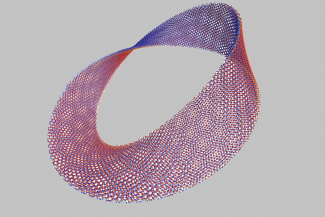
Graphene has earned the moniker of "wonder material" because it is one of the strongest known materials and has a huge variety of practical applications.
An international team led by researchers from The University of Texas at Austin has discovered new and exotic properties of graphene when it is manipulated in such a way to become a moiré material. These altered materials are made by stacking layers on top of each other and twisting them together. The research, published in Nature Physics, should help researchers further their understanding of graphene properties and unlock potential new applications down the road.
Background: For much of scientific history, materials fell into one of two classes, conductors or insulators. Conductors can conduct electricity, while insulators cannot.
Scientists and engineers have recently discovered that some materials, when manipulated a certain way, can be both conductors and insulators. The UT Austin researchers discovered this property in their twisted, double bilayer graphene.
Why it Matters: Having both of these properties means that you can essentially shut off conductivity for some parts of the material while enabling it in other areas, specifically along the edges. Typically, electrons are required as the transport vehicle to conduct electricity, but in this case, conductivity can happen without electrons.
There are practical applications — specifically in creating better field-effect transistors, which are present in many everyday electronics. But the real impact is in the fundamental science, researchers say.
“The scientific process is iterative; every step is the result of previous discoveries by others,” said Yimeng Wang, the lead author on the paper and Ph.D. student in the Cockrell School of Engineering's Department of Electrical and Computer Engineering. “These findings enhance our understanding of complex materials and exotic properties, which will ultimately help in designing better electronic devices, discovering new device architectures and enabling further breakthroughs.”
What's Next: The researchers plan to develop and probe materials that go beyond the single moiré, adding additional layers with controlled twists between each of them. Such materials may have tunable superconducting properties, magnetic states, or other exotic properties.
The Team: Emanuel Tutuc, a professor in the Department of Electrical Engineering (ECE), is the corresponding author on the paper. Other team members include Wang and G. William Burg from ECE; Jonah Herzog-Arbeitman and Andrei Bernevig from Princeton University; Jihang Zhu and Allan MacDonald from the Department of Physics at the UT Austin College of Natural Sciences; and Kenji Watanabe and Takashi Taniguchi of the National Institute of Materials Science in Japan.
